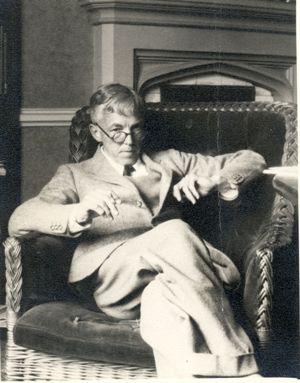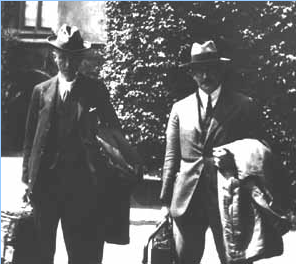Godfrey Harold Hardy
1878-1947. Professor of Pure Mathematics. 
G.H. Hardy is primarily known for his achievements in number theory and mathematical analysis.
His essay of 1940 on the aesthetics of mathematics, A Mathematician's Apology, is considered one of the best insights into the mind of a working mathematician written for the layman.
G.H. Hardy's father was Bursar and Art Master at Cranleigh School; his mother had been a senior mistress at Lincoln Training College for teachers. Both parents were mathematically inclined. Hardy's own natural affinity for mathematics was perceptible at a young age. When just two years old, he wrote numbers up to millions, and when taken to church he amused himself by factorizing the numbers of the hymns.
After schooling at Cranleigh, Hardy was awarded a scholarship to Winchester College for his mathematical work. In 1896 he entered Trinity, and after only two years of preparation he came fourth in the Mathematics Tripos. Years later, Hardy sought to abolish the Tripos system, as he felt that it was becoming more an end in itself than a means to an end. While at university, Hardy joined the Cambridge Apostles.
As his most important influence Hardy cited the self-study of Cours d'analyse de l'École Polytechnique by the French mathematician Camille Jordan, through which he became acquainted with the more precise mathematics tradition in continental Europe. In 1900 he passed part II of the tripos and was awarded a fellowship. In 1903 he earned his M.A., which was the highest academic degree at English universities at that time. From 1906 onward he held the position of a lecturer where teaching six hours a week left him time for research. In 1919 he left Cambridge to take the Savilian Chair of Geometry at Oxford in the aftermath of the Bertrand Russell affair during World War I. He returned to Cambridge in 1931, where he was Sadleirian Professor until 1942.
Hardy is credited with reforming British mathematics by bringing rigour into it, which was previously a characteristic of French, Swiss and German mathematics. British mathematicians had remained largely in the tradition of applied mathematics, in thrall to the reputation of Isaac Newton (see Cambridge Mathematical Tripos). Hardy was more in tune with the cours d'analyse methods dominant in France, and aggressively promoted his conception of pure mathematics, in particular against the hydrodynamics which was an important part of Cambridge mathematics.
 From 1911 he collaborated with J.E. Littlewood, in extensive work in mathematical analysis and analytic number theory. This (along with much else) led to quantitative progress on the Waring problem, as part of the Hardy-Littlewood circle method, as it became known. In prime number theory, they proved results and some notable conditional results. This was a major factor in the development of number theory as a system of conjectures; examples are the first and second Hardy-Littlewood conjectures. Hardy's collaboration with Littlewood is among the most successful and famous collaborations in mathematical history. In a 1947 lecture, the Danish mathematician Harald Bohr reported a colleague as saying, "Nowadays, there are only three really great English mathematicians: Hardy, Littlewood, and Hardy-Littlewood."
From 1911 he collaborated with J.E. Littlewood, in extensive work in mathematical analysis and analytic number theory. This (along with much else) led to quantitative progress on the Waring problem, as part of the Hardy-Littlewood circle method, as it became known. In prime number theory, they proved results and some notable conditional results. This was a major factor in the development of number theory as a system of conjectures; examples are the first and second Hardy-Littlewood conjectures. Hardy's collaboration with Littlewood is among the most successful and famous collaborations in mathematical history. In a 1947 lecture, the Danish mathematician Harald Bohr reported a colleague as saying, "Nowadays, there are only three really great English mathematicians: Hardy, Littlewood, and Hardy-Littlewood."
Starting in 1914, he was the mentor of the Indian mathematician Srinivasa Ramanujan, a relationship that has become celebrated. Hardy almost immediately recognized Ramanujan's extraordinary albeit untutored brilliance, and Hardy and Ramanujan became close collaborators. In an interview by Paul Erdős, when Hardy was asked what his greatest contribution to mathematics was, Hardy unhesitatingly replied that it was the discovery of Ramanujan. He called their collaboration "the one romantic incident in my life."
Hardy is also known for formulating the Hardy-Weinberg principle, a basic principle of population genetics, independently from Wilhelm Weinberg in 1908. He played cricket with the geneticist Reginald Punnett who introduced the problem to him, and Hardy thus became the somewhat unwitting founder of a branch of applied mathematics. He preferred his work to be considered pure mathematics, perhaps because of his detestation of war and the military uses to which mathematics had been applied, stating: "I have never done anything 'useful'. No discovery of mine has made, or is likely to make, directly or indirectly, for good or ill, the least difference to the amenity of the world."
His collected papers were published by OUP. The Indian Clerk (2007) is a novel by David Leavitt based on Hardy's life at Cambridge, including his discovery of and relationship with Srinivasa Ramanujan.
| Memorial inscription | Translation |
|
GODFREY HAROLD HARDY MATHEMATICAE OXONII MOX CANTABRIGIAE PROFESSOR DISCIPLINAE APVD VTROSQVE EMENDATOR PRAECLARVS IN STVDIIS PROPRIIS PER ORBEM TERRARVM INTER PRIMOS OMNIVM CONSENSV EMINENS VIR OPINIONVM IMPATIENS ALIENARVM |
Godfrey Harold Hardy was Professor of Mathematics at Oxford and then at Cambridge, and was famous for reforming methods of teaching in both places. |
G.H. HardyBrass located on the north wall of the Ante-Chapel. |
Click on the thumbnail for a larger image. |
|
|
PREVIOUS BRASS |
|
NEXT BRASS Ernest Harrison |
| Brasses A-B | Brasses C-G | Brasses H-K | Brasses L-P | Brasses R-S | Brasses T-W |

